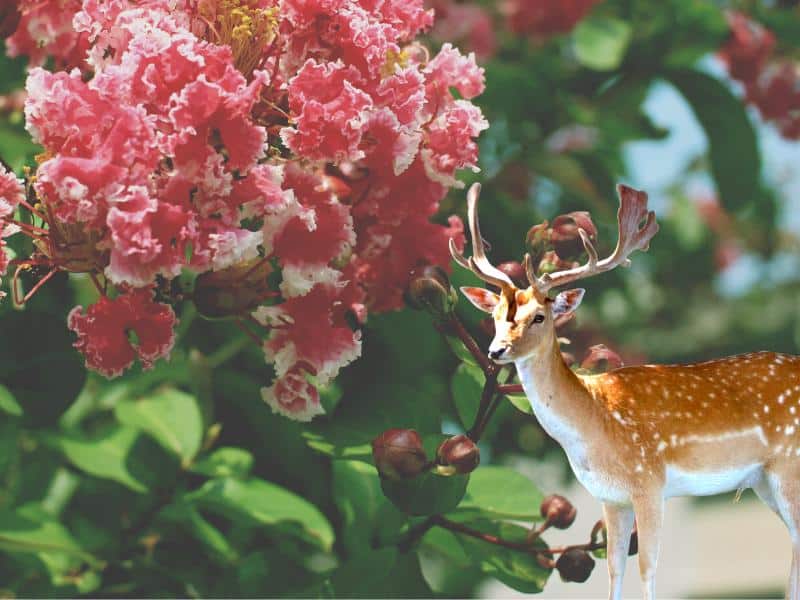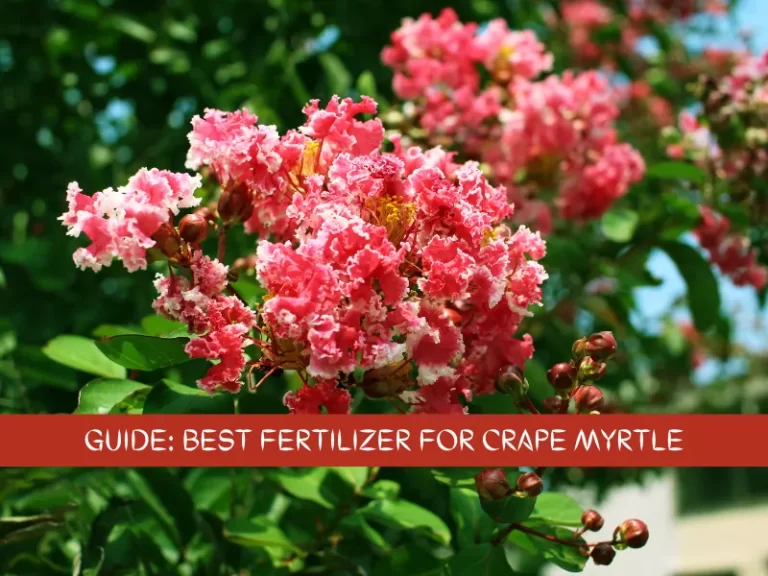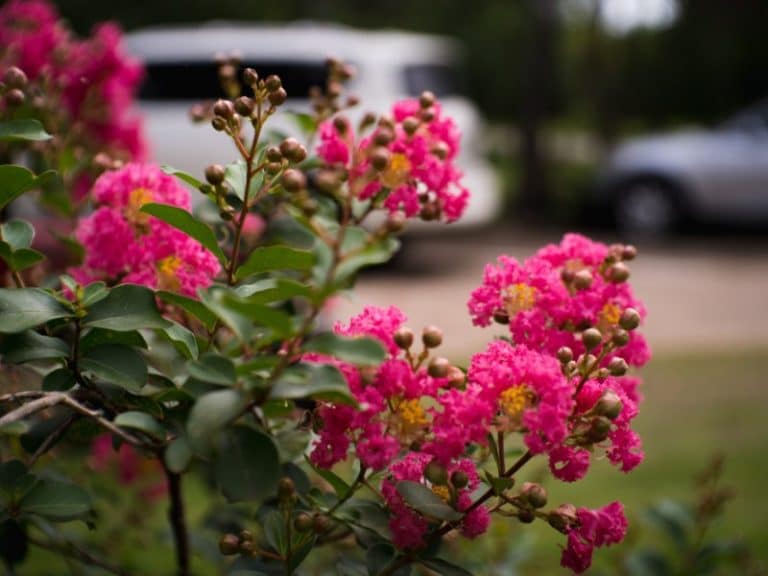Do Deer Eat Crape Myrtles?
Deer season is a mixed bag. It’s either time to hunt in allowed areas or time to keep deer off your property if you live around them. Deer are a common nuisance to most landscape plants as they browse and feed on the bark, foliage, and sometimes blooms. But do you have any cause to worry about your crape myrtles?
Deer do eat crape myrtles but in rare cases. The New Jersey Agricultural Experiment Station (NJAES) places crape myrtle in the ‘rarely damaged’ category. That means deer will rarely feed on crape myrtles. Under normal environmental conditions, the mottled bark of crape myrtles is enough to keep deer off all varieties.
Are crape myrtles deer resistant?
Crape myrtles have relatively good deer resistance. This means that deer rarely browse on plants within this family, and the plants suffer negligible damage even when they do. Nevertheless, deer will still browse crape myrtle, tripping the bark and causing physical damage when there’s a food shortage.

Deer are also more likely to feed on crepe myrtle when the available vegetation can’t sustain the food needs of the deer population.
Deer proof alternatives to crape myrtles
If you are looking for an alternative landscape plant as showy and deer resistant as crape myrtle, you’ve got lots of options.
Here are the best deer-proof alternatives to crape myrtle:
- Saucer magnolia tree
- Flowering quince
- Fragrant lilac
- Beauty bush
- Japanese flowering cherry
- Flowering dogwood
Saucer magnolia tree
Like crape myrtle, the saucer magnolia tree is rarely browsed by deer. This type of ornamental tree boasts showy blooms with a delicate shade of pink. The flowers emerge from the bare branches, whose grey color forms the perfect backdrop for the vivid blooms.
Saucer magnolia blooms in the winter, making it a great cool-season ornamental. Despite a slow growth rate, it reaches a height of 20-25 feet upon full maturity. Saucer magnolia is a sun-loving tree that thrives in USDA hardiness zones 5-9.
Note: Enhance this flowering tree’s chances of survival by maintaining moist and fertile soil conditions, especially while it’s still establishing.
Flowering quince
A member of the Chaenomeles (Spp.) family, the flowering quince tree shares key characteristics with crape myrtle. Flowering quince is a dwarf tree that rarely grows past six feet and is hardy to USDA plant hardiness zones 5-9.
Consider flowering quince if you prefer a flowering plant alternative to crape myrtle that blooms earlier in the season. This tree produces pink or red blossoms in the spring, unlike crape myrtle, which starts to bloom in the summer.
They both prefer full sunlight exposure. More importantly, both have great deer resistance.
Fragrant lilac
Deer are also known to steer clear of the fragrant lilac tree’s bark, foliage, and flowers. With its vibrant lilac or lavender blooms that appear in April, this flowering tree is great for those looking for a garden ornamental that comes to life right at the start of spring.
Fragrant lilac does well in USDA plant hardiness zones 3-7, making it an excellent crape myrtle alternative for those living further north where crape myrtle is likely to struggle.
Note: Fragrant lilac emits a distinctive, welcoming fragrance that also adds to its appeal as a landscape plant.
Beauty bush
True to its name, the Beautybush tree is a beautiful landscape tree that boasts eye-catching, pink blooms from late spring to summer. The showiness aside, it’s just as hardy. Deer prefer to stay away from it in most cases.
Beauty bush has green foliage that contrasts well with the pink flowers for added visual interest. The leaves turn red in the fall, offering a different kind of allure. Beauty bush will thrive in USDA hardiness zones 4-8.
It’s a great summer ornamental for those who prefer a flowering shrub instead of a tree.
Japanese flowering cherry
The Japanese flowering cherry, also called the Yoshino cherry, is renowned for its showy blooms with a distinctive white-pink tint. The flowers appear in the spring, making this flowering tree a garden standout. Its glossy back texture and lush green foliage only add to its visual pull.
The Yoshino cherry tree is hardy to USDA zones 5-8. But what few people know about the Japanese flowering cherry is it’s also deer resistant, like crape myrtle.
This ornamental tree releases a faint almond fragrance that ignites the senses as it blossoms.
Flowering dogwood
Flowering dogwood is another garden tree that deer prefer not to feed on, like crape myrtle. The blooms of this ornamental tree appear in the form of white or pink bracts instead of actual flowers. Meanwhile, the leaves are green and oval, while the bark is smooth and breaks down into a scale-like appearance.
Flowering dogwood prefers to grow in acidic, well-draining soil. It is well-adapted to USDA plant hardiness zones 5-9.
How to keep deer away from crape myrtles
While technically, your crape myrtle plant is safe from deer, you shouldn’t take any chances. A young, unestablished crape myrtle plant is still fair game to hungry deer. Furthermore, a young plant might not survive even minimal deer damage.
Here are some tips on keeping deer away from your crape myrtle plants.
Erect a fence
Hammer down 4-5 wood pieces — each about 2 feet tall — around newly planted crape myrtle. They will form an enclosure around the plant that prevents deer from sticking their noses through to browse on the young crape myrtle.
You can reinforce the enclosure by adding horizontal wire around the vertical wood pieces.
Use commercial deer repellent.
You can also keep off deer using either chemical repellent or mechanical repellent:
- Chemical deer repellents: These include chemical repellents that induce fear, those that inflict pain, and those that have a smell or taste that deer dislike. However, deer can become accustomed to chemical repellents after 10-12 weeks.
- Mechanical deer repellents: These include systems that mimic the eyes of deer predators, ultrasonic repellent systems, and motion-activated sprinklers.
Combine two or more of these mechanical deer repellent systems for maximum efficiency in deer prevention.
More About Crape Myrtles
- Crape Myrtle Hardiness Zones
- Ebony Flame Crape Myrtle: Care
- Pruning Crape Myrtles Correctly
- Strawberry Dazzle Crape Myrtle Care
- Midnight Magic Crape Myrtle Care
References
- Rutgers University Cooperative Extension: Landscape Plants rated by Deer Resistance




